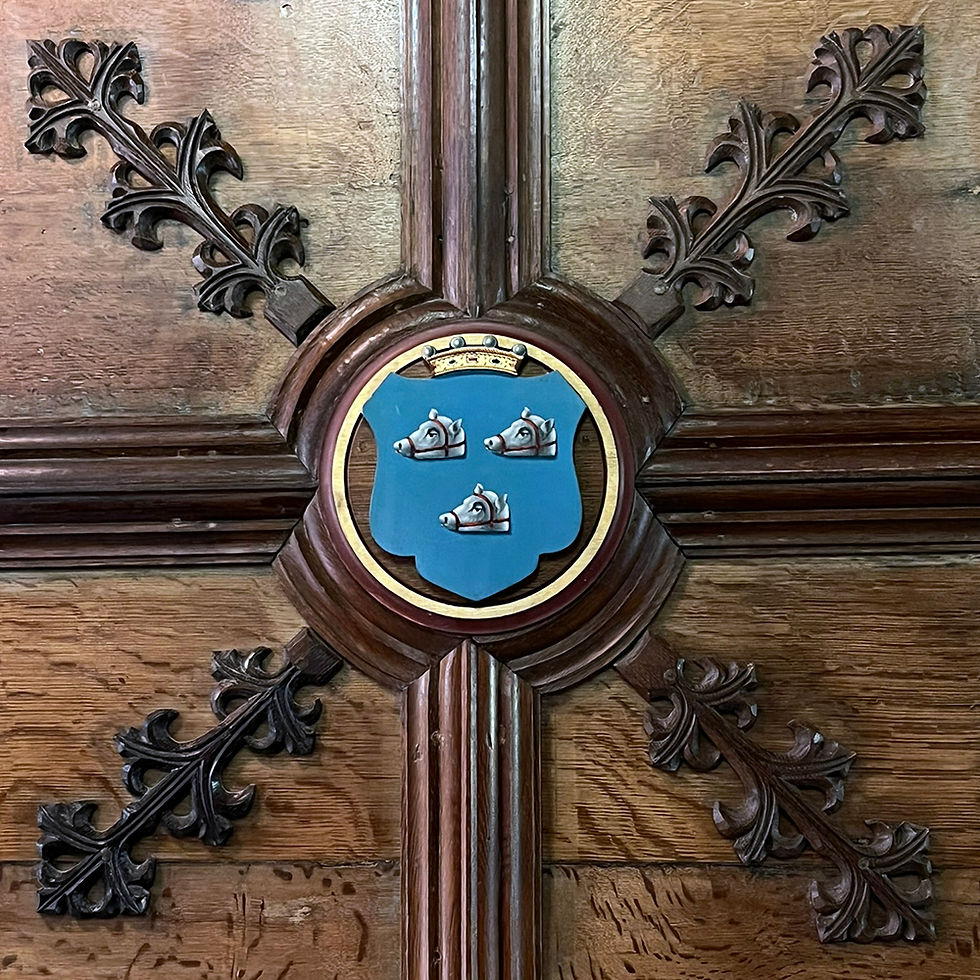Crathes Castle and Burnett of Leys
- Bart Forbes
- Sep 29, 2024
- 4 min read

The 16th-century tower house Crathes Castle is the ancestral seat of the Burnetts of Leys and includes reminders of the strong alliance with the house of Forbes. Crathes Castle was begun in the year 1553 by Alexander Burnet, 9th laird of Leys (1529-1574) and completed in 1596 by Alexander Burnett, 12th Laird of Leys. (Burnett, George. 1901. The Family of Burnett of Leys, with Collateral Branches. Aberdeen: University of Aberdeen.)
The family of Burnetts were derived from the Saxon family of “Burnard” who were granted the Crathes estate in the ancient province of Mar, by King Robert the Bruce in 1323 for their support during the Scottish wars of independence. As the authority of the mormaer (later earl) of Mar diminished, the power of their neighbors of the house of Forbes increased. Consequently, the two clans consolidated their alliance through marriage.
The first union was when one of the daughters of Alexander Forbes, 2nd laird of Echt, married as her second husband Alexander Burnett (originally “Burnard”), 6th laird of Leys. “Elizabeth, the lady of Leys, mentioned in the 1485 tack of Glenfarquhar, seems to have been a Forbes of Echt, and widow of one Alexander Riock.” (Burnett, George. 1901. The Family of Burnett of Leys, with Collateral Branches. Aberdeen: University of Aberdeen. Tayler, Alistair and Henrietta. 1937. House of Forbes. Edinburgh: Third Spalding Club.)

The second was the marriage between Alexander Burnet, 9th laird of Leys (1529-1574) and, as his second wife, Marjory, daughter of John, 6th Lord Forbes, and widow of Forbes of Brux. (Burnett, George. 1901. The Family of Burnett of Leys, with Collateral Branches. Aberdeen: University of Aberdeen.) While the laird of Leys incorporated the coat of arms of his first wife Janet Hamilton in the exterior of Crathes Castle, he included the heraldic achievement of Lord Forbes in the ceiling of his great hall.
In 1583, John “Blue Bonnet” Forbes, 3rd Laird of Newe, married Isobel Burnett of Leys and had three sons and two daughters. He built the first house of Newe, which included a stone bearing his arms (bears' heads and cinque foils of the Forbes of Pitsligo) and those of his wife, quartered with the holly leaf of the Burnetts and the letters J.F. and I.B. The castle was destroyed in 1927 but the stone with the date 1604 has been preserved. (Tayler, Alistair and Henrietta. 1937. House of Forbes. Edinburgh: Third Spalding Club.)
In 1632, Sir William Forbes, 4th Laird of Monymusk and 2nd Baronet, married Jean, daughter of Sir Thomas Burne, 13th laird of Leys and first Baronet (died 1653). Along with their alliances through marriage was a similar alignment in politics and religion. For example, on the insistence of Patrick Forbes of Corse, Bishop of Aberdeen, Sir Thomas was appointed by King James VI to a commission in 1619 which ultimately re-aligned the University of Aberdeen curriculum along more stringent Protestant ideology. (Burnett, George. 1901. The Family of Burnett of Leys, with Collateral Branches. Aberdeen: University of Aberdeen.)

Like the majority of the members of the House of Forbes, Sir Thomas also supported a Presbyterian Church of Scotland and opposed the control of King James VI and his son King Charles I over the church’s organization and doctrine. In 1644, King Charles appointed James Graham, 1st Marquess of Montrose, as Captain-General of his “Royalist” army in Scotland to oppose the Scottish “Covenanters.” While both Sir William Forbes and Sir Thomas Burnett were enjoined in the Covenanter army, Montrose marched on Monymusk House. He would have plundered and destroyed the house, but for the diplomacy Sir William's wife and Sir Thomas’s daugher, Jean Burnett of Leys. “The Marquis dynit at Monymusk with the lady, the laird being absent, and upone fair conditiones, he spairit him at this time.” (Tayler, Alistair and Henrietta. 1937. House of Forbes. Edinburgh: Third Spalding Club.) A portrait of Sir William Forbes of Monymusk (painted by George Jamesone) still hangs in Crathes Castle.

Another Forbes artifact at the castle is a vanity set displayed in the “family room.” This was donated by Bridget Forbes Burnett of Kemnay (1928 –2016.) She was born in Edinburgh as the daughter of Thomas Leslie Forbes and Eve Diane Burnett who was a Burnett of Kemnay. She was enrolled in the Convent of Sacred Hearts at Roehampton and went to live in 1945 after the war in America married Michael John Palumbo. “Bridget had six sons and spent much of her life helping many in Africa to overcome hunger and poverty.” (The Burnett Banner, Editon No.36, December 2016.)
Sir Samuel Forbes of Foveran described Crathes in 1714 immediately after the death of Sir Thomas Burnett, 15th laid of Leys and 3rd Baronet: “the house of Crathess is well built, well planted with natural and artificial wood; the gardens produce delicate fruit ; the soil is warm, the victual substantious and weighty. Sir Thomas entered with a faire and free estate, by the assistance of a kindlie tutor; had ample casualties from the Government, yet left his affairs difficulted to his son, Sir Alexander, whose commendation 'twill be to retrieve the incumbrances,” (Robertson, Joseph, Editor. 1843. Collections for a History of the Shires of Aberdeen and Banff. Aberdeen: Spalding Club.)
In spite of these financial difficulties, Crathes Caste remained in the Burnett of Leys family until 1951 when Sir James Burnett, 13th Baronet, gave it to the National Trust for Scotland.

Comments